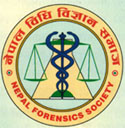NEPAL FORENSIC SOCIETY
Registered under the Nepal Law, Reg.No.622/053-54
|
|
JUSTICE BY FORENSIC SCIENCE
|
Source: Elayneschywartz, MS. D-ABCBiologyThe Forensic Biology The Forensic Biology Laboratory performs serological and DNA analyses of physiological fluids for the purpose of identification and individualization. The type of material typically examined includes, but is not limited to blood, semen, saliva and dental pulp collected at crime scenes and from articles of physical evidence. These types of physiological fluids are frequently generated during the commission of violent crimes such as homicides, rapes, assaults, and hit and run fatalities. The labís ultimate goal is to identify what type of material is present and then, through the use of DNA analysis, link that material to a specific person. The Forensic Biology section analyzes approximately 600 cases per year submitted from over 50 different law enforcement agencies throughout Westchester County. Personnel from this section perform laboratory analyses on samples submitted by police agencies as well as assisting in the processing of crime scenes. Eleven full time analysts as well as other support personnel are currently employed in this section. Biological Evidence Upon submission of biological evidence, articles are stored in a secure refrigerated walk-in cold room to await analysis. An analyst is assigned to a specific case and will bring the evidence to the evidence examination room where it is documented and analyzed. The alternate light source is utilized to locate stains that may contain blood, semen, or saliva. These stains will undergo a series of presumptive screening tests. If these stains test positive during this stage of analysis they will then be subjected to more extensive analysis, including confirmatory and DNA analysis. The DNA profiles generated from these stains will then be compared to possible known samples. Analysis The Forensic Biology section performs DNA STR
(Short Tandem Repeat) analysis. STRs offer the advantage of short analysis time,
a high degree of discrimination and the ability to look at small and degraded
samples of DNA. Samples as small as the tissue adhering to the end of a
pulled head hair, or
skin from under the nails of a victim can be compared to possible contributors.
This laboratory currently utilizes three ABI 310 single capillary
Genetic Analyzers and one
high throughput ABI 3130 multicapillary Genetic Analyzer for DNA analysis. In
addition to the analysis of autosomal STRís the laboratory also performs
analysis on STR analysis of the Y sex chromosome which is only found in males.
Analysis of Y STRís is helpful in the investigation of sexual assault cases
involving multiple male assailants. After a DNA profile is created it can be searched against local, statewide and national law enforcement databases. The Forensic Biology section is linked to the FBI CODIS (COmbined Dna Index System) DNA database network. Through this network the laboratory is able to take an unknown profile and compare it to other unsolved cases throughout the country. This CODIS link allows investigators from different jurisdictions working on serial-type cases to share important investigative information at earlier stages. Crime Scene Analysis In addition to providing analytical testing utilizing state of the art DNA technologies, the Forensic Biology/DNA sections also provide field services to law enforcement agencies investigating crime scenes. On occasion and when requested by a police agency, the forensic laboratory will provide personnel to assist in the detection and collection of biological and trace evidence at a crime scene. The laboratory can dispatch personnel trained in the use of alternate light sources and chemical enhancement techniques for the detection of blood and other body fluids should this be required. Additionally, the laboratory has on staff specially trained personnel that can examine bloodstain patterns and can provide investigational information on how these patterns may have been generated. Internet Sources
|
|
|

